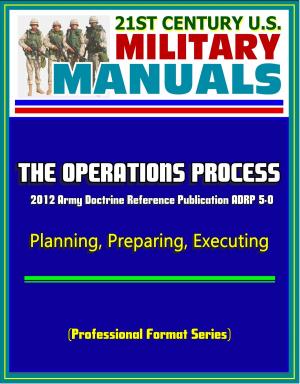Mitigation Federal Interagency Operational Plan: Core Capabilities, Federal Roles and Responsibilities, National Preparedness Goal and Executive Orders, Agency Directives, Congressional Acts
Nonfiction, Social & Cultural Studies, Political Science, Government, Social Science| Author: | Progressive Management | ISBN: | 9780463296301 |
| Publisher: | Progressive Management | Publication: | June 3, 2018 |
| Imprint: | Smashwords Edition | Language: | English |
| Author: | Progressive Management |
| ISBN: | 9780463296301 |
| Publisher: | Progressive Management |
| Publication: | June 3, 2018 |
| Imprint: | Smashwords Edition |
| Language: | English |
This important reference document has been professionally converted for accurate flowing-text e-book format reproduction.
Threats and hazards present long-term risks to people and their property. Risk is the potential for an unwanted outcome resulting from an incident, event, or occurrence, as determined by its likelihood and the associated consequences. Risk is assessed based on applicable threats and hazards, vulnerabilities, and consequences. Mitigation is risk-management action taken to avoid, reduce, or transfer those risks. By reducing the impact of disasters, mitigation supports protection and prevention activities, eases response, and speeds recovery to create better prepared and more resilient communities. The National Mitigation Framework (NMF) establishes a common platform and forum for coordinating and addressing how the Nation manages risk through mitigation capabilities. This Framework describes mitigation roles across the whole community. The Framework addresses how the Nation will lessen the impact of disaster by developing, employing, and coordinating core mitigation capabilities to reduce loss of life and property. Building on a wealth of objective and evidence-based knowledge and community experience, the Framework seeks to increase risk awareness and leverage mitigation products, services, and assets across the whole community.
The National Planning System includes the following elements: 1. a set of National Planning Frameworks that describe the key roles and responsibilities to deliver the core capabilities required to prevent, protect, mitigate, respond, and recover; 2. a set of Federal Interagency Operational Plans (FIOP), one for each mission area, that provides further detail regarding roles and responsibilities, specifies the critical tasks, and identifies resourcing and sourcing requirements for delivering core capabilities; 3. Federal department and agency operational plans to implement the FIOPs in all hazards; and 4. comprehensive planning guidance to support planning by local, state, tribal, territorial, and insular area governments, nongovernmental organizations (NGO), and the private sector.
Introduction * Purpose * Audience * Mission * Scope * Mitigation Core Capabilities * Situation * Planning Assumptions and Critical Considerations * Concept of Operations * Overview * The Mitigation Space * Interdependent Core Capabilities * Incident-Specific Mitigation * Federal Mitigation Mechanisms * Federal Roles and Responsibilities * Connection To Other Mission Areas * Oversight, Plan Development, and Maintenance * Mitigation FIOP Review Cycle * Authorities and References * National Preparedness Goal and Executive Orders * Department and Agency Directives and Congressional Acts * Appendix A: Key Terms and List of Abbreviations * Key Terms * List of Abbreviations * Appendix B: Delivery of Mitigation Core Capabilities * Threats and Hazards Identification * Risk and Disaster Resilience Assessment * Planning * Community Resilience * Public Information and Warning * Long-Term Vulnerability Reduction * Operational Coordination
This important reference document has been professionally converted for accurate flowing-text e-book format reproduction.
Threats and hazards present long-term risks to people and their property. Risk is the potential for an unwanted outcome resulting from an incident, event, or occurrence, as determined by its likelihood and the associated consequences. Risk is assessed based on applicable threats and hazards, vulnerabilities, and consequences. Mitigation is risk-management action taken to avoid, reduce, or transfer those risks. By reducing the impact of disasters, mitigation supports protection and prevention activities, eases response, and speeds recovery to create better prepared and more resilient communities. The National Mitigation Framework (NMF) establishes a common platform and forum for coordinating and addressing how the Nation manages risk through mitigation capabilities. This Framework describes mitigation roles across the whole community. The Framework addresses how the Nation will lessen the impact of disaster by developing, employing, and coordinating core mitigation capabilities to reduce loss of life and property. Building on a wealth of objective and evidence-based knowledge and community experience, the Framework seeks to increase risk awareness and leverage mitigation products, services, and assets across the whole community.
The National Planning System includes the following elements: 1. a set of National Planning Frameworks that describe the key roles and responsibilities to deliver the core capabilities required to prevent, protect, mitigate, respond, and recover; 2. a set of Federal Interagency Operational Plans (FIOP), one for each mission area, that provides further detail regarding roles and responsibilities, specifies the critical tasks, and identifies resourcing and sourcing requirements for delivering core capabilities; 3. Federal department and agency operational plans to implement the FIOPs in all hazards; and 4. comprehensive planning guidance to support planning by local, state, tribal, territorial, and insular area governments, nongovernmental organizations (NGO), and the private sector.
Introduction * Purpose * Audience * Mission * Scope * Mitigation Core Capabilities * Situation * Planning Assumptions and Critical Considerations * Concept of Operations * Overview * The Mitigation Space * Interdependent Core Capabilities * Incident-Specific Mitigation * Federal Mitigation Mechanisms * Federal Roles and Responsibilities * Connection To Other Mission Areas * Oversight, Plan Development, and Maintenance * Mitigation FIOP Review Cycle * Authorities and References * National Preparedness Goal and Executive Orders * Department and Agency Directives and Congressional Acts * Appendix A: Key Terms and List of Abbreviations * Key Terms * List of Abbreviations * Appendix B: Delivery of Mitigation Core Capabilities * Threats and Hazards Identification * Risk and Disaster Resilience Assessment * Planning * Community Resilience * Public Information and Warning * Long-Term Vulnerability Reduction * Operational Coordination















